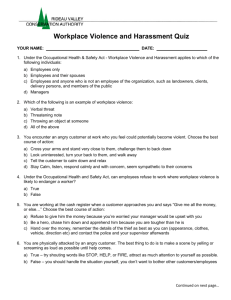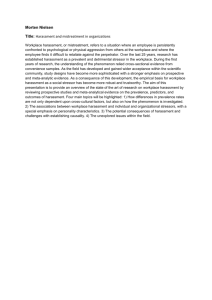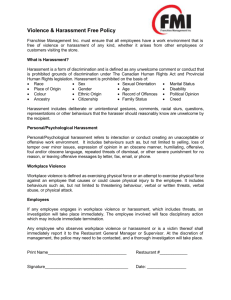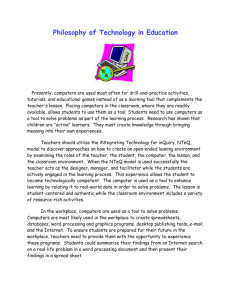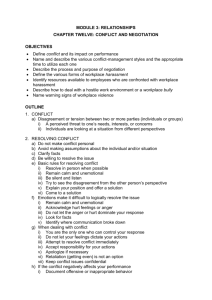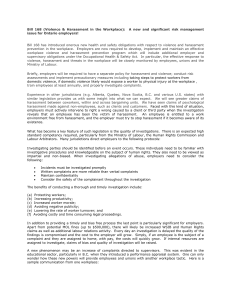Supervisor Training Program
advertisement
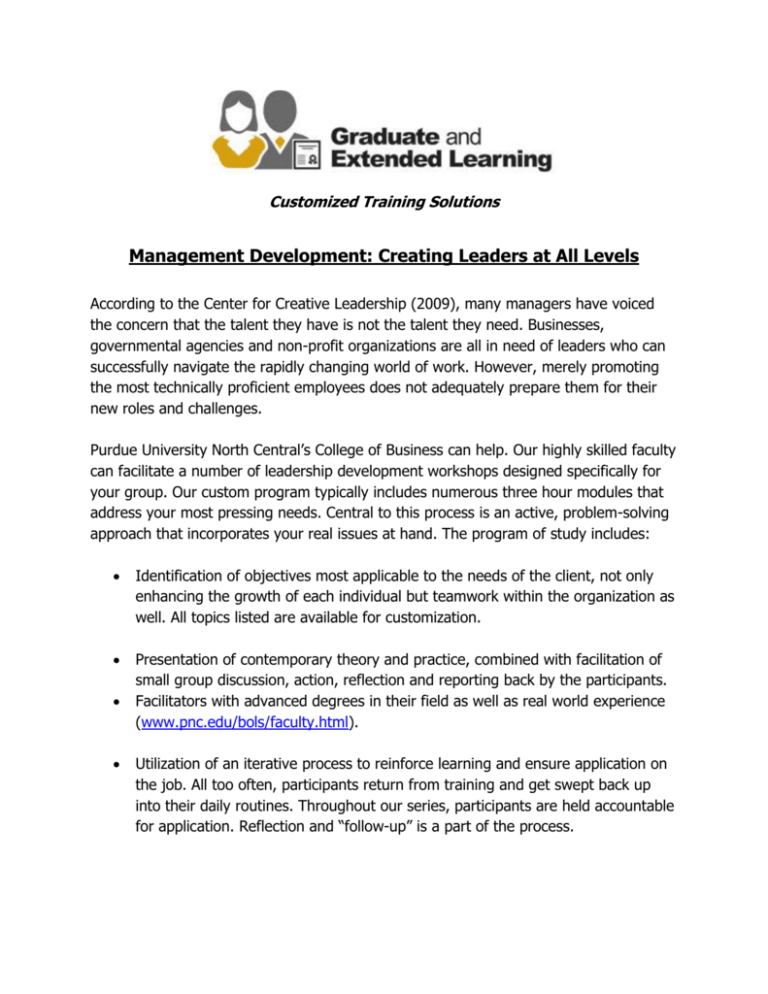
Customized Training Solutions Management Development: Creating Leaders at All Levels According to the Center for Creative Leadership (2009), many managers have voiced the concern that the talent they have is not the talent they need. Businesses, governmental agencies and non-profit organizations are all in need of leaders who can successfully navigate the rapidly changing world of work. However, merely promoting the most technically proficient employees does not adequately prepare them for their new roles and challenges. Purdue University North Central’s College of Business can help. Our highly skilled faculty can facilitate a number of leadership development workshops designed specifically for your group. Our custom program typically includes numerous three hour modules that address your most pressing needs. Central to this process is an active, problem-solving approach that incorporates your real issues at hand. The program of study includes: Identification of objectives most applicable to the needs of the client, not only enhancing the growth of each individual but teamwork within the organization as well. All topics listed are available for customization. Presentation of contemporary theory and practice, combined with facilitation of small group discussion, action, reflection and reporting back by the participants. Facilitators with advanced degrees in their field as well as real world experience (www.pnc.edu/bols/faculty.html). Utilization of an iterative process to reinforce learning and ensure application on the job. All too often, participants return from training and get swept back up into their daily routines. Throughout our series, participants are held accountable for application. Reflection and “follow-up” is a part of the process. Client-centered approach to learning that incorporates the client organization’s standards and policies. Interactive class assignments and exercises for practical application using common workplace scenarios. With reinforced new knowledge and skills, participants see the relevance and immediate application of instruction to their worksite and are encouraged by the results that emerge from their own involvement and efforts. Overview: Courses are designed to be presented in 3-hour sessions. This allows for immediate problem-solving opportunities and practical application when discussion of real-world work issues occurs. Custom Topics from A-Z Appreciative Inquiry Managers will learn about the Appreciative Inquiry theory which searches for the best in people, their organizations, and the relevant world around them. It deliberately seeks to discover people’s exceptionality – their unique gifts, strengths, and qualities. In its broadest focus, it involves systematic discovery of what gives “life” to a system when it is most alive and most effective. At the conclusion of this training participants will be able to: 1. Discuss characteristics of effective communication and review the psychological process of change. 2. Recognize the organizational leadership traits that are used 3. Provide practical activities to enhance the art of asking questions that strengthen a system’s capacity to apprehend, anticipate, and heighten positive potential. 4. Apply concepts of appreciative inquiry to an issue within their immediate workgroup. Change Management This topic emphasizes fundamentals of change management, the change process, and obstacles to changes. This course also covers managing and adapting to change, coping with uncertainty, and moving forward. At the conclusion of the training participants will be able to: 2 1. 2. 3. 4. Apply the fundamentals of change management. Implement the change process and handle obstacle to change. Manage change through creativity, developing commitment, and communication. Adapt to change, cope with uncertainty and move forward. Coaching for Success This topic provides techniques for ongoing performance feedback and skills for recognizing a coaching opportunity. It encourages supervisors to get involved with the performance growth of their team members to develop and enhance their skills. At the conclusion of this training participants will be able to: 1. Recognize the need to encourage others toward personal growth opportunities. 2. Seek out the potential of another person and support the person’s need to take on additional responsibilities. 3. Invite others to stretch their comfort zone of skills and reach new levels of potential. Communication Managers will develop verbal skills for communicating well under ordinary circumstances 1. Making a request, suggestion, proposal or demand 2. Gathering information, lots of information – questioning 3. Listening and proving that you are listening – paraphrasing 4. Restarting a stalled conversation – positioning 5. Offering proofs when you have proof 6. Rebutting when you don’t have proof or care a lot 7. Closing for lasting understandings 8. One use for verbal skills Managers will develop some techniques for communicating under difficult circumstances 1. Using verbal skills with difficult people 2. Delivering negative messages as positively as possible Communication Part 2: Refining Skills Managers will develop these skills: 1. I-Messages I-Messages for equal and unequal relationships 3 2. Effective Delegation Assessment When to delegate What to delegate How to delegate: Four-step cycle (allocation of duties, delegation of authority, assignment of responsibility, creation of accountability) 3. The Modern World of Communication General recommendations for written material Eight recommendations for email communications Eight recommendations for phone communications Conflict Resolution This topic teaches the meaning of conflict, the nature of relationships and the behavior necessary to resolve conflict, especially between two or more groups acting in a competitive manner due to perceived or actual incompatible goals or limited resources At the conclusion of this training participants will be able to: 1. Understand the nature of a relationship, the course of conflict and the appropriate communication strategies used in addressing the differences. 2. Use and recognize verbal and nonverbal messages. 3. Effectively manage differences. Corrective Action This topic provides participants with a proactive approach to managing employees who demonstrate performance or behavior problems. At the conclusion of this training participants will be able to: 1. 2. 3. 4. 5. Understand the need to take corrective action. Describe the performance or behavior gap, clearly and specifically. Document performance discrepancies and take appropriate corrective action. Prepare for a performance discussion with an advisor. Conduct a corrective counseling discussion with an advisor. Diversity This topic provides an introduction to diversity in the workplace. At the conclusion of this training, participants will: 4 1. 2. 3. 4. Understand two approaches to diversity and history of diversity laws. Be able to explain the changing profile of today’s workers. Understand and avoid stereotyping. Be aware of best practices in workplace diversity. Emotional Intelligence Emotional Intelligence (EI) is a new perspective on the way people inter-relate; the "street smarts" in a person. It reflects on their ability to deal successfully with other people, their feelings, and their everyday social environment. By dealing with these pressures successfully, a person will be better able to positively influence their overall well- being. At the conclusion of this training participants will be able to: 1. 2. 3. 4. Understand the leadership style of the emotionally-intelligent leader. Enhance leadership presence and authenticity. Learn what it takes to be an inspiring leader. Assemble practical tools and techniques for personal mastery and relationship mastery. 5. Create a personal development plan. Hiring the Best This topic presents a structured process for hiring the best candidate for the position. At the conclusion of this training, participants will be able to: 1. 2. 3. 4. 5. Review and understand the formal approval process. Utilize a hiring flowchart as a resource for completing the hiring process. Analyze a job to identify minimum technical and performance skills. Prepare applicant selection criteria for the skills identified in the job analysis. Write interview questions that are legal and focus on behavior relevant to applicant qualifications. 6. Screen applicants for interview. 7. Conduct an employment interview using prepared interview questions. 8. Analyze pre-employment assessment results. 9. Select the most qualified candidate for the position based on information obtained during an employment interview and from references. 10. Make a job offer that is not an implied employment contract. Hiring the Best Part 2: From the Offer Letter to Your Door This is the second part of the Hiring the Best series, focused on making the new hire’s first day a positive, memorable experience. At the conclusion of this session, participants will be able to: 5 Ensure that the new hire will have the appropriate resources to be successful, such as space, computer access, supplies, telephone, security clearances, and other documentation. Describe elements of an effective orientation program. Develop a departmental training program. Human Resource Essentials This topic presents an overview of the various laws and regulations with which every supervisor must understand and comply. Additionally, it provides a summary of your company’s Human Resource policies. At the conclusion of this session, participants will be able to: 1. Overview and understanding of the following laws and regulations: American Disability Act -ADA Family Medical Leave Act - FMLA Equal Employment Opportunity – Affirmative Action Plan - EEO/AAP Worker’s Compensation 2. Overview and understanding of the following company policies and practices: Personal Paid Time Off Performance Documentation Vacation Policy Ethics Point Sick Day Code of Conduct Dress Code Self Development Harassment Time & Attendance Improving Quality and Productivity: People, Process, and Data-informed Practice This topic focuses on methods for analyzing and improving work productivity. It helps participants explore productivity issues in their work area, introduces effective techniques for identifying opportunities for productivity improvement and methods for generating solutions to address productivity obstacles. At the conclusion of the training participants will be able to: 1. Explain the importance of analyzing and improving productivity in today’s work environment. 2. Define and measure productivity. 3. Identify opportunities for productivity improvement. 4. Identify obstacles to productivity. 5. Develop and evaluate productivity improvement ideas. 6. Develop action plans to implement productivity improvement ideas. 6 Leadership and Effective Followership Although much has been written about effective leadership, how does it differ from effective management? And can leaders be effective without effective followers? This topic explores the differences between leadership and management, applications of current leadership theory, and the role of effective followers. Upon completion of this training participants will be able to: 1. Explain the differences between leadership and management, and the importance of each. 2. Discuss a variety of current leadership theories (trait, behavioral, process, relational, and collective) presented in an easy-to-understand format. 3. Gain a greater awareness of their personal leadership style. 4. Discuss the role of effective followers. Managing Time at Work This topic provides the participants with the understanding and skills necessary to effectively manage their time on the job. Tools provided in the course can be used individually or incorporated into an existing planning system the participants currently have. The session focuses on how to organize and prioritize daily tasks, manage workflow, develop a daily plan, manage interruptions and manage computer information. At the conclusion of the training participants will be able to: 1. 2. 3. 4. 5. 6. Describe why time management is important. Use a planning form to organize tasks. Prioritize and adjust daily tasks. Utilize efficient work area techniques. Handle interruptions. Utilize time saving tips for the computer. Meetings That Work This topic focuses on how to effectively lead meetings and use them as productive methods to communicate, solve problems and make decisions. It covers the appropriate reasons for holding meetings, the characteristics and typical structure of meetings, principles and tools for planning, leading, and participating in meetings and how to handle distracting problem behaviors. At the conclusion of the training participants will be able to: 1. Describe the benefits of effective group meetings for organizations and individual group members. 2. Identify appropriate reasons for holding a meeting. 3. List the characteristics of effective meetings. 7 4. Complete key meeting planning and preparation activities. 5. Apply effective principles to lead and participate in effective meetings. Performance Management This topic will provide participants with a proactive approach to performance management by focusing on setting clear expectations, specific performance feedback and objective performance evaluations. At the conclusion of this training participants will be able to: 1. 2. 3. 4. 5. 6. Write performance objectives based on measurable criteria and standards. Communicate clear performance and behavior expectations. Objectively observe performance. Provide feedback to employees and document the discussions. Prepare and conduct the performance appraisal. Utilize the Performance Management system. Project Management This topic presents the practical application of the concepts in the day-to-day planning and execution of projects. The program material covers all of the essential aspects of project management, such as developing the project scope and schedule, creating a project management plan, and developing a communications plan. At the conclusion of this training participants will be able to: 1. 2. 3. 4. 5. Understand the knowledge areas of project management. Know the steps required to plan and manage a project. Utilize planning tools for a project. Understand the characteristics of a project and its deliverables. Know the most common phases of a project life cycle and the typical project management tasks associated with each. Reward & Recognition This topic discusses techniques to utilize to recognize, reward, and motivate team members toward continued and improved performance. Participants will explore effective and ineffective forms of recognition and the consequences of failing to recognize individuals. At the conclusion of this training participants will be able to: 1. Diagnose motivational problems, and discuss various incentives for performance improvement. 2. Brainstorm reasons for and ways to recognize success. 8 3. Discuss appropriate methods of delivering recognition, and the outcomes of ineffective recognition plans. Servant Leadership This topic explores the concepts of servant leadership and applies servant leadership concepts to the analysis of real life situations. It will also organizational problems related to servant leadership issues and evaluate suitable solutions. At the conclusion of this training participants will be able to: 1. Understand the concepts of servant leadership 2. Identify objectives that can enhance the growth of individuals in the organization and increase teamwork and personal involvement. 3. Recognize the organization’s leadership traits that are used. 4. Complete interactive exercises using common workplace scenarios. 5. Report on action plans for skills assessment. Sexual Harassment Awareness This topic is designed to provide participants with an overview of sexual harassment law and related definitions. Emphasis is placed on explaining what sexual harassment is under federal law, identifying the kinds of behavior that may be interpreted as sexual harassment in the workplace, avoiding sexual harassment, dealing with sexual harassment as it arises, and participating in an investigation of allegations of sexual harassment. At the conclusion of this training participants will be able to: 1. Sensitize employees about discriminatory harassment and their critical role in prevention. 2. Be responsible for identifying and helping to prevent discriminatory harassment in the workplace. 3. Encourage workplace respect and courtesy and act as role-models to improve productivity. 4. Create a workplace environment where potential victims of discriminatory harassment can discuss their concerns without legal retaliation. True Colors True Colors is a four-category color metaphor for understanding differences in personal preferences or personalities to achieve more effective working and personal relationships. At the conclusion of the training, participants will be able to: 1. Identify their own character traits (personal preferences) and become aware of how they relate to others in their professional and personal roles 2. Identify others’ personal preference styles and become aware of how they relate to their colleagues 9 3. Work with these differences more successfully 4. Modify (within limitations) or coordinate their own styles to get more of the results they desire Workplace Violence This topic helps participants understand the magnitude of violence in the workplace and know how to identify potentially violent employees/non-employees and be able to effectively manage incidents before they occur. At the conclusion of this training participants will be able to: 1. 2. 3. 4. Recognize methods for detecting and identifying threats of violence Identify situations most likely to lead to violence Implement practical steps for addressing actual workplace violence situations Successfully deal with workplace violence situations Also Available: Practical Application The clinical nature of classroom instruction depends upon the personal commitment of participants to retain and apply the knowledge and skills they have gained. Often, too, the culture of the environment, or simply the demands of the job works against any immediate or long term transfer of the "play" in the classroom to the reality on site. With reinforced new knowledge and skills, participants see the relevance and immediate application of instruction to their worksite and are encouraged by the results that emerge from their own involvement and efforts. At the conclusion of this training participants will be able to: 1. Scrutinize work related situations. 2. Identify transitional relevance to the theories/concepts learned. 3. Recognize how leadership traits can be applied. Computer Software Training: Access Computer Basic for the Beginner Excel Photoshop PowerPoint QuickBooks Web Site Design Word 10 Conversational Languages: American Sign Language Chinese English as a Second Language Italian Spanish Financial Topics for Non-Financial Managers: Analyzing Financial Statements Capital Project Analysis Cost Variance Analysis Developing the Cash Budget Financial Information, the Decision Making Process, and Revenue Determination Financial Mathematics General Principles of Accounting and Financial Statements Product Costing and Management Control Strategic Financial Planning, Cost Concepts and Decision Making Working Capital and Cash Management Safety and Health Training: Confined Spaces Developing a Safety Plan for Your Organization Electrical/Arc Flash Safety Fire Safety Forklift and Other Powered Truck Safety HazMat Safety Hearing Conservation Industrial Hygiene Laboratory Safety Lockout/Tagout Machine Guarding Material Handling OSHA Training Personal Protective Equipment Respiratory Protection Slips, Trips and Falls Walking and Working Surfaces Misc.:` Lean Manufacturing Marketing Techniques Non-Profit Management Project Management Public Speaking Six Sigma Sustainability Total Quality Management Working Across Cultures Working with Various Generations 11
